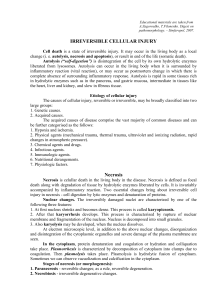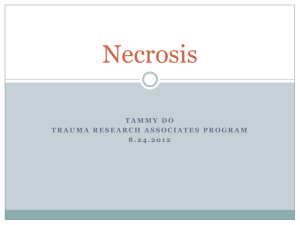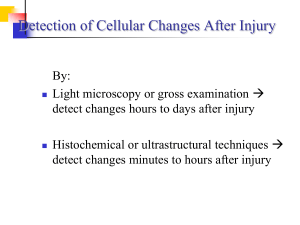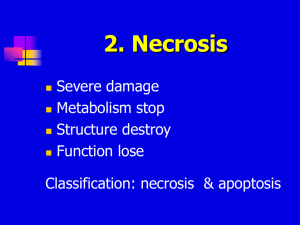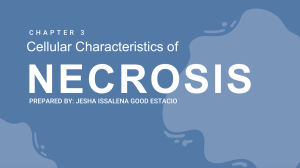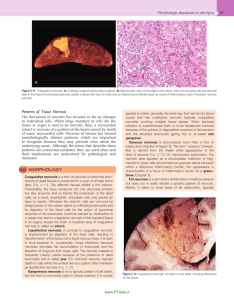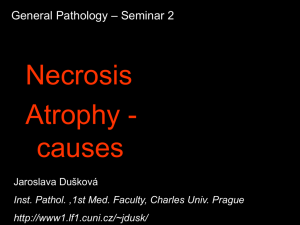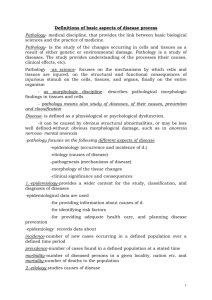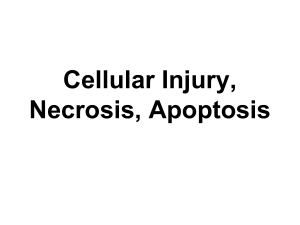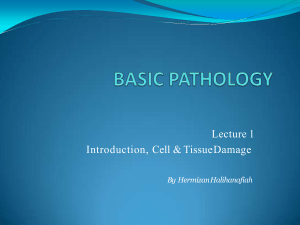General pathology
advertisement
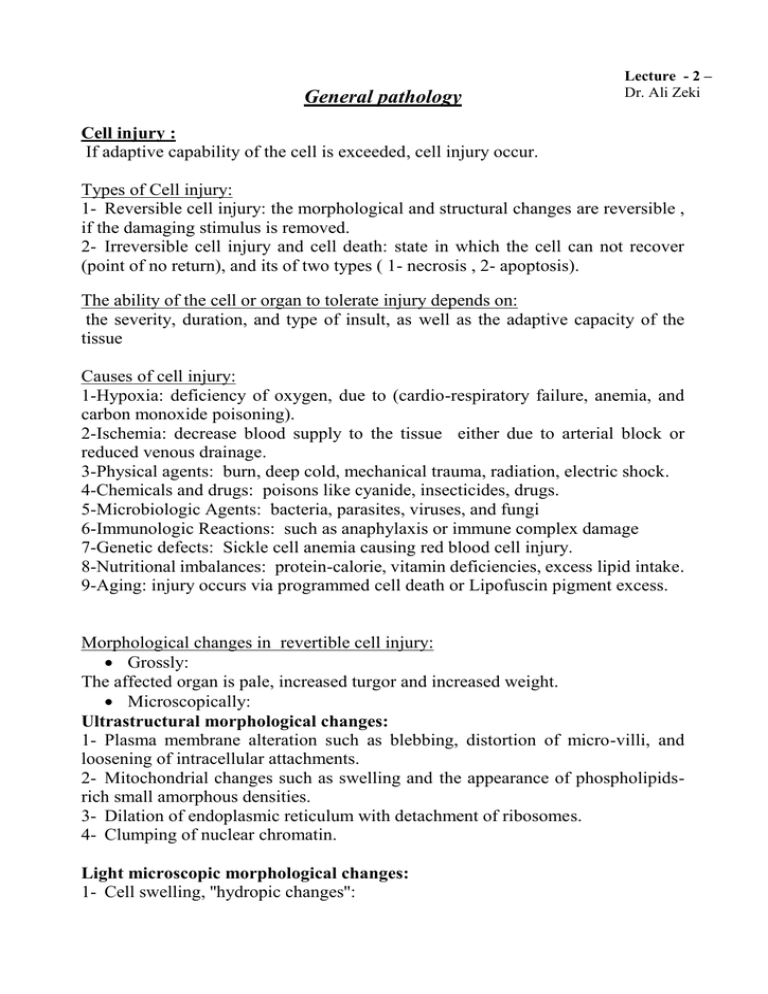
General pathology Lecture - 2 – Dr. Ali Zeki Cell injury : If adaptive capability of the cell is exceeded, cell injury occur. Types of Cell injury: 1- Reversible cell injury: the morphological and structural changes are reversible , if the damaging stimulus is removed. 2- Irreversible cell injury and cell death: state in which the cell can not recover (point of no return), and its of two types ( 1- necrosis , 2- apoptosis). The ability of the cell or organ to tolerate injury depends on: the severity, duration, and type of insult, as well as the adaptive capacity of the tissue Causes of cell injury: 1-Hypoxia: deficiency of oxygen, due to (cardio-respiratory failure, anemia, and carbon monoxide poisoning). 2-Ischemia: decrease blood supply to the tissue either due to arterial block or reduced venous drainage. 3-Physical agents: burn, deep cold, mechanical trauma, radiation, electric shock. 4-Chemicals and drugs: poisons like cyanide, insecticides, drugs. 5-Microbiologic Agents: bacteria, parasites, viruses, and fungi 6-Immunologic Reactions: such as anaphylaxis or immune complex damage 7-Genetic defects: Sickle cell anemia causing red blood cell injury. 8-Nutritional imbalances: protein-calorie, vitamin deficiencies, excess lipid intake. 9-Aging: injury occurs via programmed cell death or Lipofuscin pigment excess. Morphological changes in revertible cell injury: Grossly: The affected organ is pale, increased turgor and increased weight. Microscopically: Ultrastructural morphological changes: 1- Plasma membrane alteration such as blebbing, distortion of micro-villi, and loosening of intracellular attachments. 2- Mitochondrial changes such as swelling and the appearance of phospholipidsrich small amorphous densities. 3- Dilation of endoplasmic reticulum with detachment of ribosomes. 4- Clumping of nuclear chromatin. Light microscopic morphological changes: 1- Cell swelling, ''hydropic changes'': small, clear vacuoles seen within the cytoplasm, these represent distended and pinched-off segments of endoplasmic reticulum. 2- Fatty changes" manifested by the appearance of lipid vacuoles within the cytoplasm. Morphological changes in Irreversible cell injury ''Necrosis'': Necrosis refers to a sequence of morphological changes that follow cell death in living tissue (not fixed specimens). The morphological appearance of necrosis is due to two processes: 1- Enzymatic digestion of the cell. 2- Denaturation of the proteins. The hydrolytic enzymes may derived either from the dead cells themselves, in which case the digestion is referred as 'autolysis', or from the lysosomes of invading inflammatory cells termed 'hetrolysis'. Cytoplasm changes in necrotic cell: Dead cell show: 1- Increased eosinophilia (pink staining from eosin dye), this is due to increased binding of eosin to denaturated intracytoplasmic proteins, and in part to loss of the basophilia that is normally imparted by the RNA in the cytoplasm. 2- The necrotic cell have more glassy homogenous appearance than viable cells due to mainly to loss of glycogen particles. 3- When enzyme have degraded the organelles, the cytoplasm becomes vacuolated and appears 'moth-eaten'. 4- The calcification of the dead cell may occur. Nuclear changes in necrotic cell: 1- Pyknosis: It characterized by nuclear shrinkage and increased basophilia of the nucleus, the DNA condenses into a solid shrunken mass. 2- Karyolysis: DNAse activation lead to non-specific DNA breakdown, and this lead to decrease basophilia of the nucleus. 3- Karyorrhexis: Fragmentation of the nucleus . Types of necrosis: 1-Coagulative necrosis: which is the most common type, occurs in response to Ischemia in all tissues of the body except CNS, characterized by preserves cell outline, and denaturation of proteins 2-Liquefactive necrosis: occur due to bacterial infection, CNS ischemia, and characterized by lose of all architecture due to enzyme digestion 3-Fat necrosis: this type of necrosis seen in pancreatic lipases escape and digest adipose tissue into free fatty acids with accumulation of calcium that shows up as chalky white areas, its seen in pancreatitis, and in cases of trauma to the fatty tissue like the breast. 4-Caseous necrosis: its a special form of coagulative necrosis associated with some granulomatous infections such as TB, characterized by formation of white cheesy debris surrounded by a granuloma. 5- fibrinoid necrosis: its an alteration of connective tissues especially arterial walls, infiltrated by strongly eosinophilc hyaline material which shows some of the characterization of fibrin. 6- Gangrene This is a clinical descriptive entity, represent cell necrosis in association with variable degree of bacterial infection. Types a. Dry gangrene * most commonly occurs in the extremities * usually the result of ischemic coagulative necrosis * the necrotic area appears black, sharply demarcated, dry, shrivelled * secondary bacterial infection minimal or not significant b. Wet gangrene * usually seen in necrotic bowel * severe bacterial super infection occurs * the necrotic area is swollen, and reddish-black with extensive liquefaction * typical foul odor due to bacterial fermentation c. Gas gangrene * occurs in wound infected by clostridium.s * extensive necrosis of tissue and production of gas by bacteria * (crackling sound) can be felt over the site clinically .

